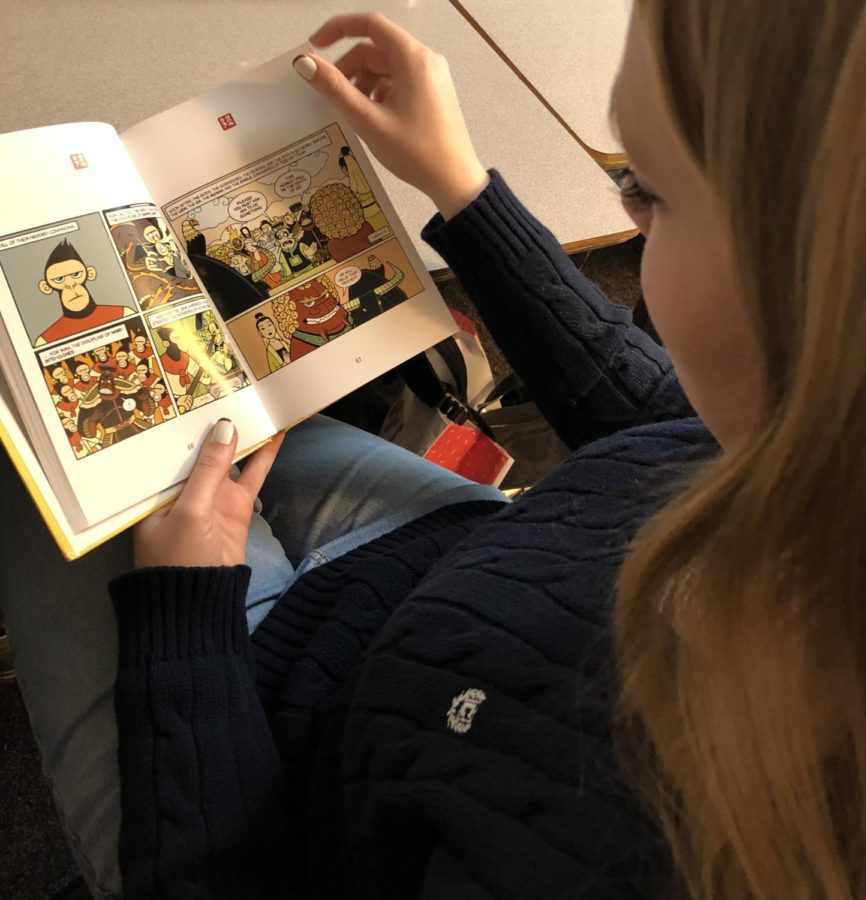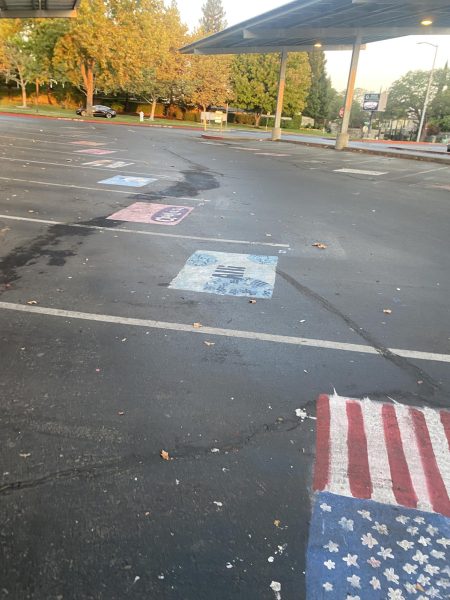Graphic Novels Taught for The First Time in CP English 9 Course
Illustration by Riley Davidson
Students sit down to read American Born Chinese, which has content and a style of literature that has raised concerns through parents and the students themselves.
Most students enrolled in the CP English 9 course in Granite Bay High School are or are scheduled to read “American Born Chinese,” a graphic novel composed by author Gene Luen Yang.
Due to a majority agreement made by English 9 teachers Julie Francesconi, Stephanie May, Shannon McCann and Matthew Plastino, the addition was made as the 2022-2023 school year started. To increase their visual literacy, students participate in daily discussions and analyze “American Born Chinese.”
Last year, Matthew Plastino was a temporary teacher at Antelope High School. As this semester’s substitute for Christy Honeycutt, he too has participated in multiple meetings regarding the CP English 9 course.
“When (the idea of teaching multimodal texts) was introduced, I was very vocal about my support on (it),” Plastino said. “I saw the effect it had on Antelope; there was a high level of student engagement…, comprehension and understanding with it and I thought that was really interesting and something that we can add to Granite Bay.”
Like Plastino, department coordinator David Tastor supports using graphic novels as a teaching method.
He did not play a role in the CP English 9 instructors final decision.
“The teachers in English 9 wanted to give…the accessibility of reading (to) all students….(and to) allow students to access literature that they may not normally,” Tastor said.
In other words, literacy at Granite Bay is adapting.
For instance, Plastino realized that an approach at further engaging students has been presented through multimodal novels.
“Originally, I got started reading Calvin and Hobbes comic books (because) I never really found any kind of piece of literature that really spoke to me,” Plastino said. “A lot of modern storytelling is done through visual mediums, like movies or TV shows…, (so) I think multimodal texts (are) a really good way to engage students who may not be totally set on reading a novel.”
As a result, the CP English 9 teachers are expecting those taking the course to broaden their abilities in visual analysis in order to further their conclusion-making.
Specifically, the graphic novel unit exercises literary skills such as summarizing, questioning, clarifying and predicting as students distinguish features within panels.
According to Tastor and Plastino, the Granite Bay English department looks to bring visual analysis to most English-related courses. Plastino envisions students enhancing their knowledge and preparedness for future units through graphic novels and the classroom practices that accompany them.
“A lot of the skills (students learn from graphic novels) pertain to regular novels,…such as analyzing…, but the nice thing…(is that) they add another layer with visual analysis,” Plastino said. “We can understand the character through the way the author describes them, but we get a different sense of that when we actually look at images on a page.”
Junior Sofia Baumgartner is currently taking Plastino’s class. As she transferred from Oakmont High School, this is her first time reading novels like “American Born Chinese” in an English course.
After she compared both experiences, the similarity between lessons involving multimodal texts and those with traditional books became clear, and therefore part of the department’s intentions with introducing graphic novels.
“(Visual analysis) teaches you how to analyze what’s going on (in the panels and) to understand the book fully…to where, when you are reading a book with no images…you’re going to have that practice,” Baumgartner said.
For her, it’s “the stepping stone into…having a more challenging curriculum.”
Some of those still reading “American Born Chinese” have also formulated their own opinion.
“Normally, I read chapter books,” freshman Jude Alvasheer said, “but it’s very nice to switch it up and see how the author…wants (the story) to be projected to us.”
Not only does Yang communicate his fictional work through illustrations, but also structures it to communicate key themes that he found to be prevalent in his youth.
These themes include identity, friendship, pride and stereotypes.
“(American Born Chinese) is a different story than the story that is predominantly told in America,” Tastor said. “One of the things that we’re asked to do in California standards is to teach diverse perspectives.”
With such a popular novel, Yang’s perspective has reached thousands of audiences who have taken its themes to heart.
Baumgartner believes that his message is the reason the English department chose “American Born Chinese” as one of the first novels students read in high school.
“(American Born Chinese) talks about themes…like identity…that I feel are important for students to be learning about…especially coming into high school (and) being a freshman,” Baumgartner said. “You might not feel like you’re part of something and…it teaches you to stay true to yourself.”
Alvasheer developed a similar perspective after an in-class deep-dive into Yang’s work.
“When Danny turns out to be Jin, it really shows you how…you can lose yourself so far that you don’t even recognize yourself,” Alvasheer said. “It’s important to always return to who you are so you can always be happy and comfortable with who you are.”
Despite the mature themes presented in “American Born Chinese,” however, some students and parents are skeptical regarding the rigor of multimodal texts.
Graphic novels were a talking point among select parents during the site council meeting on Oct. 12, which discussed worries regarding literature available to Granite Bay students.
Katie Lang, the parent of two students currently enrolled at Granite Bay, introduced the concern.
“Graphic novels…(are) cartoon books with Lexile levels in the 600s,” Lang said. “We’re all talking about preparing for college, being smart, educated children and moving on and becoming adults…(so) I’m wondering why multiple books are at this level in high school.”
However, Plastino continues to trust and defend the new addition to the curriculum.
“(There’s) a misconception that (graphic novels are) something that’s more for entertainment value…but you can find deeper themes in…everything and graphic novels are not an exception,” Plastino said. “Parents and students will come to snap judgments based on literally judging a book by it’s cover.”
Plastino also advised those worried about the introduction of the unit to read American Born Chinese itself, which he instructed students to do as a weekend assignment soon after it started.
“I (originally thought) ‘why aren’t we reading out of, like, a chapter book?’…Now that I’ve read the novel and we’re going over it, I realized a lot of graphic novels have a deeper meaning,” Alvasheer said, proving Plastino’s thought.
Plastino has made the effort to address possible issues with the mature themes students find in the graphic novel.
“Oftentimes, there are racial stereotypes and ethnic slurs that are used in (American Born Chinese), so having a discussion before that, and how that can be damaging and offensive to some people, is an important conversation to have,” Plastino said. “I’ve noticed after having those conversations, those kinds of inappropriate discussions have been minimized, and in fact, almost gone.”
In short, Plastino has prepared for discussions varying from plot to sterotypes in order to maximize students’ learning.
According to Tastor, “Trust your teachers to be professional, because we are professional.”













GB parent • Nov 20, 2022 at 10:44 am
Well written and very informative!!